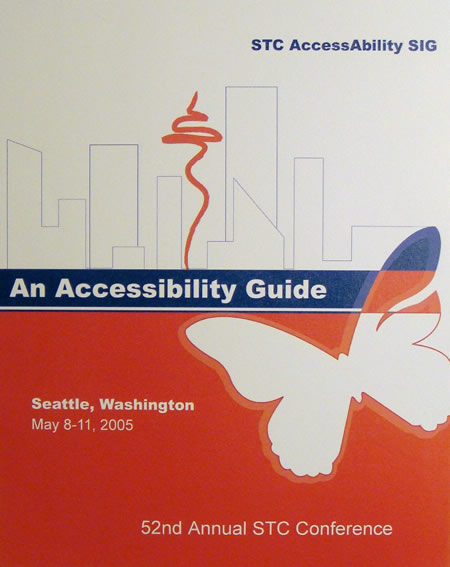
The Conference Accessibility Guide of the Society for Technical Communication (STC) had its debut at the STC 2002 conference in Nashville. It was developed as a volunteer project by the STC AccessAbility Special Interest Group (SIG). The guide was a source of information for all conference attendees with accessibility issues to ensure their stay was comfortable and as trouble-free as possible.
What Does the Guide Cover?
Covering mobility, vision, and hearing needs, the guide includes information about transportation to the conference venue and the facilities at the conference. By facilities, we mean signage, lighting, sound, service animal care, floor covering, elevators, meeting rooms, and more, including: are these things accessible, and if not, what are the issues? It also offers tips for both speakers and attendees on ways to hear presentations better.
Happily, the guide has been able to drop some topics over the years. Dietary requirements are now covered in the conference registration process. Information about sightseeing and exploring the city is now covered by the host chapter.
What are the Benefits?
Anecdotal evidence indicates that the guide is here to stay. One wheelchair user tells us that he could only attend the conference thanks to the peace-of-mind he got from the details in the guide.
Within the SIG, members feel it is an incredible learning experience that raises their awareness of accessibility needs. Although originally written for conference attendees with special needs, the guide has gradually revealed its universal value to all attendees with its practical information about getting to and around at the conference venue. The guide is now considered an integral part of the conference logistics.
How is it Delivered?
For the first six years, a printed guide was provided at the conference with a PDF on the conference website. Two years ago, the guide “went green” and switched to HTML format on the website. User feedback had pointed out that airport information was unnecessary in a printed guide at the destination and that online information was adequate. However, there are still some who want something tangible available at the conference to raise awareness of accessibility and to help publicize the work of the SIG. Despite the use of smartphones or laptops, some people still prefer a paper document for finding their way around the facilities.
Whatever its format, the guide must follow accessibility guidelines. That is part of the branding for the SIG. Any PDF or HTML must be easily read by anyone, with or without assistive technology.
What has the Guide Taught Us?
Persistence. Raising awareness about accessibility takes time, but persistence pays off.
Marketing. There is room for improvement in the marketing of the guide. The name “guide” caused confusion when we moved to the HTML format; some people looked for an actual guide or a PDF file. Leaving it in HTML format allows for last-minute updates. But a format that is easily printed (and prettier than a print of a web page) is something to consider.
Collaboration. This is an excellent team project for members of both the SIG and the local host chapter. Members of STC can make a valuable contribution to the organization and develop personal skills in writing, designing, planning, and editing, as well as building their own knowledge about accessibility and usability.
Accessibility. Even as we write about accessibility, we continue to learn. For example, bathrooms at one convention center had accessible stalls, but a wheelchair user could not hold the door open and navigate her chair into the bathroom at the same time. The door opened inward so when she left the bathroom, well, she couldn’t! The stall was accessible, but the bathroom was not.
Dialog. Working online, we hope to make the guide more dynamic. The primary information about accessibility is on the conference site, but we can add additional information on our blog in posts leading up to the conference. People are welcome to ask questions or contribute information there.
What Lies Ahead?
For 2010, we are working on a model template or checklist that can be used for future STC conferences and to promote the concept of these guides outside STC. Local chapters and other organizations can use the template to gather the information needed to make the guide useful. We hope that attendees will promote the concept in their workplaces so the idea of accessibility guides spreads to all conferences.
Contributions are welcome so that the guide can continue to be improved. Current and past conference guides are available at www.stcaccess.org/conference-accessibility-guide/.
